九年级英语上册 Unit 4 全单元教案 冀教版
- 格式:doc
- 大小:81.01 KB
- 文档页数:11
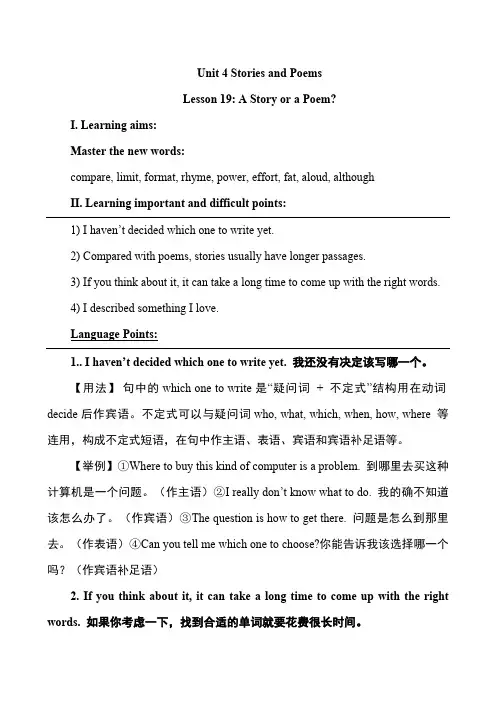
Unit 4 Stories and PoemsLesson 19: A Story or a Poem?I. Learning aims:Master the new words:compare, limit, format, rhyme, power, effort, fat, aloud, althoughII. Learning important and difficult points:1) I haven’t decided which one to write yet.2) Compared with poems, stories usually have longer passages.3) If you think about it, it can take a long time to come up with the right words.4) I described something I love.Language Points:1.. I haven’t decided which one to write yet. 我还没有决定该写哪一个。
【用法】句中的which one to write是“疑问词+ 不定式”结构用在动词decide后作宾语。
不定式可以与疑问词 who, what, which, when, how, where 等连用,构成不定式短语,在句中作主语、表语、宾语和宾语补足语等。
【举例】①Where to buy this kind of computer is a problem. 到哪里去买这种计算机是一个问题。
(作主语)②I really don’t know what to do. 我的确不知道该怎么办了。
(作宾语)③The question is how to get there. 问题是怎么到那里去。
(作表语)④Can you tell me which one to choose?你能告诉我该选择哪一个吗?(作宾语补足语)2. If you think about it, it can take a long time to come up with the right words. 如果你考虑一下,找到合适的单词就要花费很长时间。
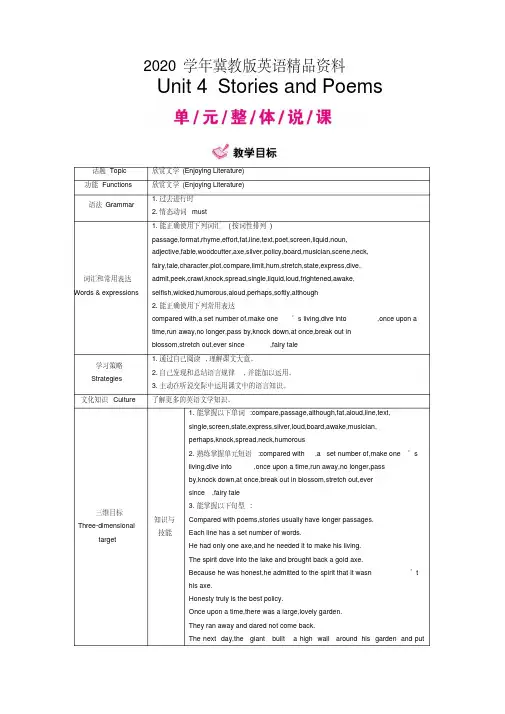
2020学年冀教版英语精品资料Unit 4 Stories and Poems话题Topic 欣赏文学(Enjoying Literature)功能Functions 欣赏文学(Enjoying Literature)语法Grammar 1.过去进行时2.情态动词must词汇和常用表达Words & expressions 1.能正确使用下列词汇(按词性排列)passage,format,rhyme,effort,fat,line,text,poet,screen,liquid,noun,adjective,fable,woodcutter,axe,silver,policy,board,musician,scene,neck,fairy,tale,character,plot,compare,limit,hum,stretch,state,express,dive,admit,peek,crawl,knock,spread,single,liquid,loud,frightened,awake,selfish,wicked,humorous,aloud,perhaps,softly,although2.能正确使用下列常用表达compared with,a set number of,make one’s living,dive into…,once upon a time,run away,no longer,pass by,knock down,at once,break out inblossom,stretch out,ever since…,fairy tale学习策略Strategies 1.通过自己阅读,理解课文大意。
2.自己发现和总结语言规律,并能加以运用。
3.主动在听说交际中运用课文中的语言知识。
文化知识Culture 了解更多的英语文学知识。
三维目标Three-dimensionaltarget 知识与技能1.能掌握以下单词:compare,passage,although,fat,aloud,line,text,single,screen,state,express,silver,loud,board,awake,musician,perhaps,knock,spread,neck,humorous2.熟练掌握单元短语:compared with…,a set number of,make one’sliving,dive into…,once upon a time,run away,no longer,passby,knock down,at once,break out in blossom,stretch out,eversince…,fairy tale3.能掌握以下句型:Compared with poems,stories usually have longer passages.Each line has a set number of words.He had only one axe,and he needed it to make his living.The spirit dove into the lake and brought back a gold axe.Because he was honest,he admitted to the spirit that it wasn’this axe.Honesty truly is the best policy.Once upon a time,there was a large,lovely garden.They ran away and dared not come back.The next day,the giant built a high wall around his garden and puta notice on a board:DO NOT ENTER!三维目标Three-dimensionaltarget知识与技能He thought it must be the king’s musicians passing by.He was trying to reach up to the spreading branches of a tree.At once the tree broke out in blossom.The little boy stretched out with his arms,put them around thegiant’s neck and kissed him.I like reading stories,but they are very hard to write.Then my teacher encouraged me to write a humorous poem because Iam always saying funny things.4.能了解以下语法:①过去进行时;②情态动词must。
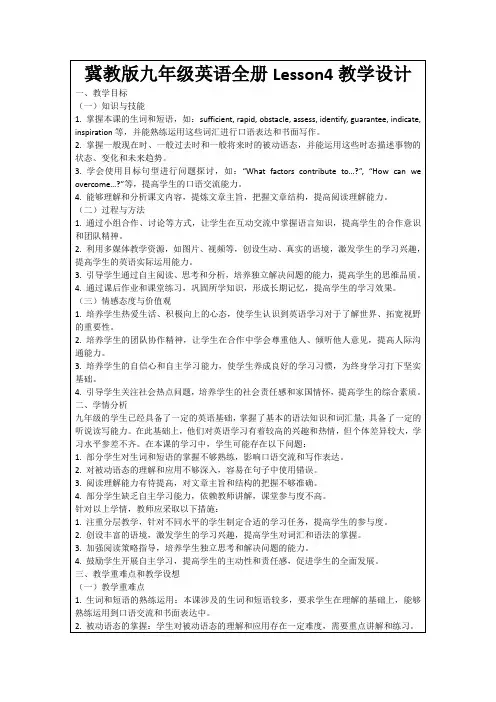
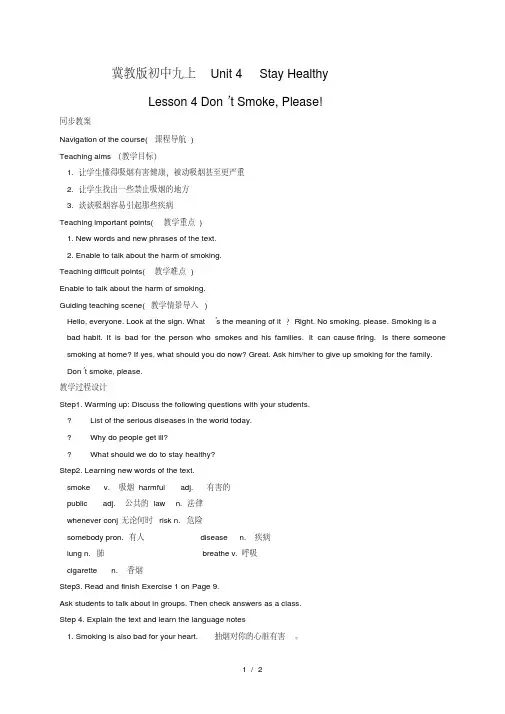
冀教版初中九上Unit 4 Stay HealthyLesson 4 Don’t Smoke, Please!同步教案Navigation of the course(课程导航)Teaching aims(教学目标)1. 让学生懂得吸烟有害健康,被动吸烟甚至更严重2. 让学生找出一些禁止吸烟的地方3. 谈谈吸烟容易引起那些疾病Teaching important points(教学重点)1. New words and new phrases of the text.2. Enable to talk about the harm of smoking.Teaching difficult points(教学难点)Enable to talk about the harm of smoking.Guiding teaching scene(教学情景导入)Hello, everyone. Look at the sign. What’s the meaning of it?Right. No smoking, please. Smoking is a bad habit. It is bad for the person who smokes and his families. It can cause firing. Is there someone smoking at home? If yes, what should you do now? Great. Ask him/her to give up smoking for the family. Don’t smoke, please.教学过程设计Step1. Warming up: Discuss the following questions with your students.?List of the serious diseases in the world today.?Why do people get ill??What should we do to stay healthy?Step2. Learning new words of the text.smoke v. 吸烟harmful adj. 有害的public adj. 公共的law n. 法律whenever conj无论何时risk n. 危险somebody pron. 有人disease n. 疾病lung n. 肺breathe v. 呼吸cigarette n. 香烟Step3. Read and finish Exercise 1 on Page 9.Ask students to talk about in groups. Then check answers as a class.Step 4. Explain the text and learn the language notes1. Smoking is also bad for your heart. 抽烟对你的心脏有害。
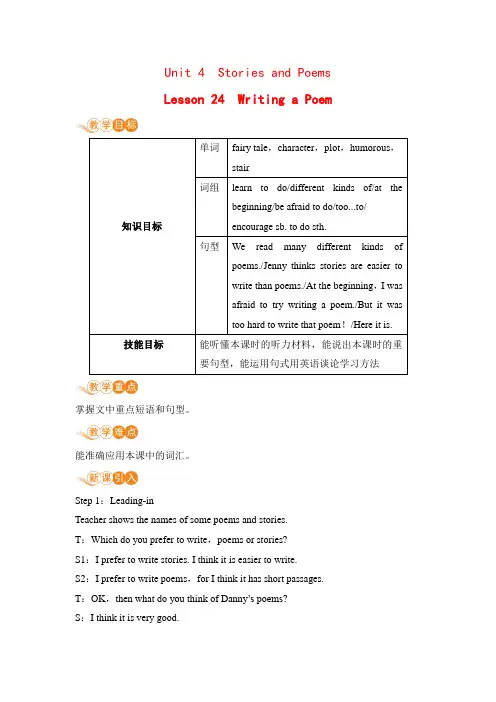
Unit 4 Stories and Poems Lesson 24 Writing a Poem知识目标单词fairy tale,character,plot,humorous,stair词组learn to do/different kinds of/at the beginning/be afraid to do/too...to/encourage sb. to do sth.句型We read many different kinds of poems./Jenny thinks stories are easier towrite than poems./At the beginning,I wasafraid to try writing a poem./But it wastoo hard to write that poem!/Here it is.技能目标能听懂本课时的听力材料,能说出本课时的重要句型,能运用句式用英语谈论学习方法掌握文中重点短语和句型。
能准确应用本课中的词汇。
Step 1:Leading-inTeacher shows the names of some poems and stories.T:Which do you prefer to write,poems or stories?S1:I prefer to write stories. I think it is easier to write.S2:I prefer to write poems,for I think it has short passages.T:OK,then what do you think of Danny’s poems?S:I think it is very good.T:Today we will learn a lesson about Danny’s diary and Danny’s poem. Now let’s start!设计意图:新课开始,教师通过设计几个学生感兴趣的问题导入新课,能调动他们的学习积极性。
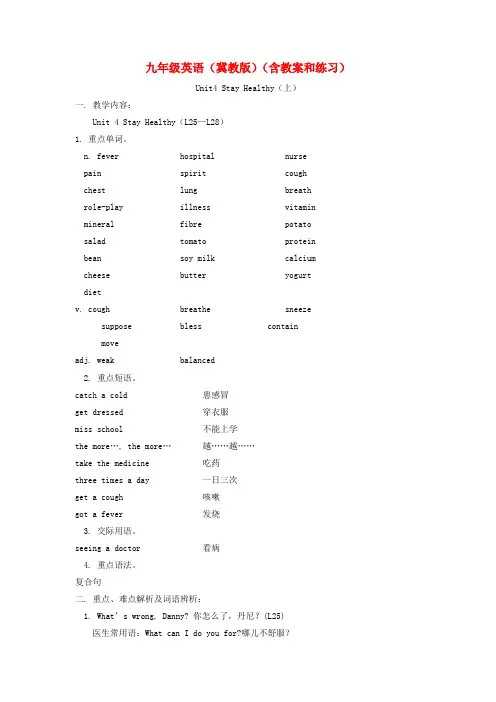
九年级英语(冀教版)(含教案和练习)Unit4 Stay Healthy(上)一. 教学内容:Unit 4 Stay Healthy(L25—L28)1. 重点单词。
n. fever hospital nursepain spirit coughchest lung breathrole-play illness vitamin mineral fibre potatosalad tomato proteinbean soy milk calcium cheese butter yogurtdietv. cough breathe sneeze suppose bless containmoveadj. weak balanced2. 重点短语。
catch a cold 患感冒get dressed 穿衣服miss school 不能上学the more…, the more…越……越……take the medicine 吃药three times a day 一日三次get a cough 咳嗽got a fever 发烧3. 交际用语。
seeing a doctor 看病4. 重点语法。
复合句二. 重点、难点解析及词语辨析:1. What’s wrong, Danny? 你怎么了,丹尼?(L25)医生常用语:What can I do you for?哪儿不舒服?Where does it hurt? 哪儿痛?What’s the trouble? 怎么了?What’s the matter with you? 你哪不舒服?2. You are si ck, aren’t you? 你病了,不是吗?(L25)这是反意疑问句。
反意疑问句是由一个陈述句和一个简短的附加疑问句构成的。
原则是前否定后肯定。
但是需要注意下面几点:⑴当前边带有hardly,never,few,little,nothing等词时,后边用肯定句形式。
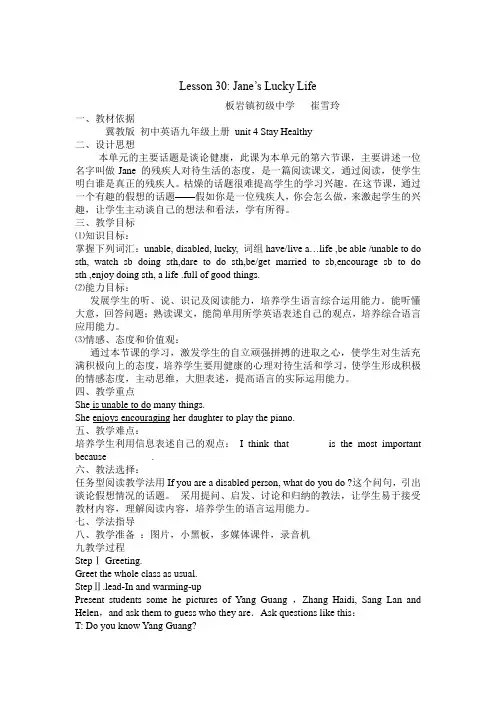
Lesson 30: Jane’s Lucky Life板岩镇初级中学崔雪玲一、教材依据冀教版初中英语九年级上册unit 4 Stay Healthy二、设计思想本单元的主要话题是谈论健康,此课为本单元的第六节课,主要讲述一位名字叫做Jane 的残疾人对待生活的态度,是一篇阅读课文,通过阅读,使学生明白谁是真正的残疾人。
枯燥的话题很难提高学生的学习兴趣。
在这节课,通过一个有趣的假想的话题——假如你是一位残疾人,你会怎么做,来激起学生的兴趣,让学生主动谈自己的想法和看法,学有所得。
三、教学目标⑴知识目标:掌握下列词汇:unable, disabled, lucky, 词组have/live a…life ,be able /unable to do sth, watch sb doing sth,dare to do sth,be/get married to sb,encourage sb to do sth ,enjoy doing sth, a life .full of good things.⑵能力目标:发展学生的听、说、识记及阅读能力,培养学生语言综合运用能力。
能听懂大意,回答问题;熟读课文,能简单用所学英语表述自己的观点,培养综合语言应用能力。
⑶情感、态度和价值观:通过本节课的学习,激发学生的自立顽强拼搏的进取之心,使学生对生活充满积极向上的态度,培养学生要用健康的心理对待生活和学习,使学生形成积极的情感态度,主动思维,大胆表述,提高语言的实际运用能力。
四、教学重点She is unable to do many things.She enjoys encouraging her daughter to play the piano.五、教学难点:培养学生利用信息表述自己的观点:I think that _______is the most important because_________.六、教法选择:任务型阅读教学法用If you are a disabled person, what do you do ?这个问句,引出谈论假想情况的话题。
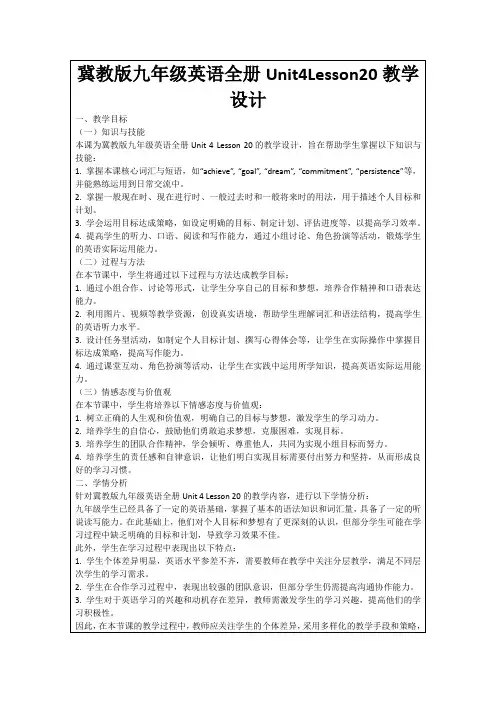
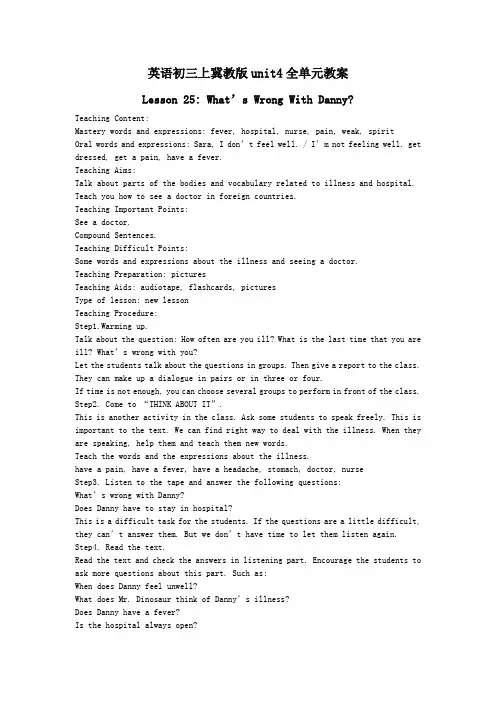
英语初三上冀教版unit4全单元教案Lesson 25: What’s Wrong With Danny?Teaching Content:Mastery words and expressions: fever, hospital, nurse, pain, weak, spiritOral words and expressions: Sara, I don’t feel well. / I’m not feeling well. get dressed, get a pain, have a fever.Teaching Aims:Talk about parts of the bodies and vocabulary related to illness and hospital. Teach you how to see a doctor in foreign countries.Teaching Important Points:See a doctor.Compound Sentences.Teaching Difficult Points:Some words and expressions about the illness and seeing a doctor.Teaching Preparation: picturesTeaching Aids: audiotape, flashcards, picturesType of lesson: new lessonTeaching Procedure:Step1.Warming up.Talk about the question: How often are you ill? What is the last time that you are ill? What’s wrong with you?Let the students talk about the questions in groups. Then give a report to the class. They can make up a dialogue in pairs or in three or four.If time is not enough, you can choose several groups to perform in front of the class. Step2. Come to “THINK ABOUT IT”.This is another activity in the class. Ask some students to speak freely. This is important to the text. We can find right way to deal with the illness. When they are speaking, help them and teach them new words.Teach the words and the expressions about the illness.have a pain, have a fever, have a headache, stomach, doctor, nurseStep3. Listen to the tape and answer the following questions:What’s wrong with Danny?Does Danny have to stay in hospital?This is a difficult task for the students. If the questions are a little difficult, they can’t answer them. But we don’t have time to let them listen again.Step4. Read the text.Read the text and check the answers in listening part. Encourage the students to ask more questions about this part. Such as:When does Danny feel unwell?What does Mr. Dinosaur think of Danny’s illness?Does Danny have a fever?Is the hospital always open?Who is the doctor?What does the doctor say to Danny?Check the answers and give them enough hints to answer the questions.Step5. Act out:Act out the dialogue in front of the class. Make another dialogue to perform in the class. The roles are doctors and patients and the patients’ family members. Divide the class into several groups and act out the role-play in front of the class. Choose the best one and give them praise.Step6. Come to “LET’S DO IT”.Make up a dialogue in front of the class. When they are acting, help them when it is necessary. Teach them more new words about illness and parts of the body. Step7. HomeworkFinish off the activity book.Go on the next reading in the student book.Summary:Remember to teach the students to be a good person when they grow up. It is important for every teacher in every class. When the teacher comes to “LET’S DO IT”. We must go to help the old and children in our daily life because we must have love in our hearts. Love is the forever subject in the life. The teacher must teach them the importance of being people.Lesson 26: Where Is Danny?Teaching Content:Mastery words and expressions: cough, chest, lung, breathe, catch a cold, suppose, illnessOral words and expressions: sneeze, bless, blessed, blest, role-play, miss school, got a cough, catch a cold, take this medicine three times a dayTeaching Aims:Learn more expressions for describing illness and treatment.Know how to see a doctor in foreign countries.Teaching Important Points:Know some knowledge about the illness and the treatment.Go to see a doctor.Teaching Difficult Points:Know some words and expressions about the illness and the treatment.Teaching Preparations: picturesTeaching Aids: audiotape, flashcards, picturesType of lesson: new lessonTeaching Procedure:Step1.Warming-upTalk in groups about the showings about the cold. The teacher asks the students “When you catch a cold, how do you feel?” Let the students sum the phenomenon of the cold. Then give a report in the class. They can begin like this: when I have a fever, I…S1: When I have a cold, I have a fever.S2: When I have a cold, I often cough day and night.S3: When I have a cold, I often have a running nose.S4: When I have a cold, I often have a headache.Step2. Come to “THINK ABOUT IT”.Talk about the following question: “What do your father and mother usually tell you to do when you catch a cold?”At the same time, ask the students to talk about the question: “What do your parents do when you are ill? How do they feel when you are ill?”S5: My father and mother usually tell me to drink more water and take medicine three times a day.When I’m ill, my mother looks after me at home. She can’t go to work.S6: My parents tell me to keep warm and drink more water. When I have to get an injection, my parents are sad.S7: My parents often tell me to play inside and take medicine. When I am ill, my parents are worried.Step3.Listening taskListen to the tape and answer the following questions:What’s wrong with Brian?What does Jenny do to help Brian?Finish the exercises in oral in class.Step4. Reading taskRead the text and fill in the blanks according to the text.1. _______ almost never gets sick.2.Brian’s ________ and _______ hurt.Jenny brought some _______ _______ for lunch.Jenny says to Brain: “_______ _______.”Finish the blanks in class in oral.pletethedialogues.Inthegroup,oneisapat ient.Anotherisadoctor.Theotherscanbethenursesorthepatients’familymembers. Letthestudentsgraspthewordsandexpressionsofillnessandtreatment.Encouragethestud entstoreadtheirstudentbooksandreaderstofindoutfactsaboutcasesandsymptomsofcommo nillness.Aftertheygraspmorewordsandexpressionsabouttheillness,theycanbegintherole-play. Intheprocess,thepatientsdescribewhattheyfeelandwhattheydotocuretheillness.Ifthe yneednewwordsthattheydon’tknow,theteachercanhelpthem.Ifthedoctorcan’thavebettertreatmenttothepatients’illness,thedoctorcantellthepatientstohaveagoodrestanddrinkalotofwater.Step6.HomeworkFinishofftheactivitybookGoonthenextreadinginthestudentbook.Summary: LetthestudentstosearchontheInternettogetmoreinformationaboutthecausesandsymptom sofcommonillness.Encouragestudentstoassisteachotherinfindingandunderstandingthe information.TheyshouldwritedownwhattheysearchedontheInternetbecausetheyhavetogi veareportlaterintheclass.Lesson27:GoodFood,GoodHealthTeachingContent:Masterywordsandexpressions:potato,salad,tomato,cheese,butter Oralwordsandexpressions:vitamin,mineral,fibre,protein,bean,soymilk,calcium,yogu rt,contain,balanced,dietTeachingAims:Wemusteathealthyandkeephealthy.Knowaboutthebalanceddiet.TeachingImportantPoints: Knowmorewordsaboutthenamesofthegraininourdailylife. Howtoeathealthyandkeephealthy/TeachingDifficultPoints:Whatisabalanceddiet?TeachingPreparation:picturesTeachingAids:audiotape,flashcards,picturesTypeoflesson:newlessonTeachingProcedure:Step1.warmingup:Talkaboutthequestion:whatdoyoueatinyourdailylife?Doyouthinkwhatthefoodsyoueatco ntain?Somewordsaretoodifficultforthemtoanswer,sotheteachershowssomenewwordstothemwith theflash.Somewordsaretoodifficulttolearn.Letthestudentsreadaftertheaudiotapeforseveralti mestohavecorrectpronunciation.Step2.Readthetextandanswerthefollowingquestions:Whatdobread,noodlesandricecomefrom?Isfruitdifferentfromvegetables?Answerthequestionsinclassinoral.Iftheycan’tanswerthemcorrectly,letthemreadthetext.Helpthemfindthecorrectanswer.Step3.Readthetextindetailsandfinishtheexercises. Readthetextandfillintheblanks:1.Bread,noodlesandricearemadefrom_______.2______and_______areverygoodsourceof________,_______and_______.3.____________aremadefrompotatoes.4.Saladismadeof_______________.5.Manypeoplethinkthatonlymeatandchickenhave_______.______makesyourbonesandteethstrong.Step4.Listentothetapeandletthestudentsfollowitfortwotime.Letthemhavethecorrectp ronunciationandintonation.Step5.Asksomestudentstoreadthetextintheclass.Don’treadthewholetext,readonlytheimportantwords,expressionsandsentences.eto“LET’SDOIT”. Fillinthecharttocomparetheeatinghabitsofyourclassmates.Interviewfourormorestudentstofillinthechart.Theycandesignmorequestionstoasktheo thers.Step7.HomeworkFinishofftheactivitybook.GoonthenextreadinginthestudentbookSummary: Therearesomanynewwordsandexpressionsinthistext.Makeupsentenceswiththenewwordsan dexpressions.Whenthestudentstalkaboutthefoodtheyareeating,showthemthenewwordsan dletthemuseintheirdialogue.Listentothetapeforseveraltimesandletthestudentsimita teafteritinordertohavegoodEnglish.Lesson28:MoveYourWholeBodyTeachingContent:Masterywordsandexpressions:moveTeachingAims:Wemusteathealthytokeepahealthybody.Befamiliartotheforeignsongs.TeachingImportantPoints:1.Talkingabouthealthybodies.poundsentences.TeachingDifficultPoints:Thedrill:themore…themore…TeachingPreparation:picturesTeachingAids:audiotape,flashcards,picturesTypeoflesson:newlessonTeachingProcedure:Step1.Warmingup:Talkaboutthefollowingquestions:Howtokeephealthy?Doyouthinkwhatyoueatinyourdaily lifearethemostuseful?Dividetheclassintoseveralgroupsanddiscussthem,thenletsomestudentsreportinfronto ftheclass.Payattentiontotheiropinions.Aretheyscientific? Ifyouhaveanydoubtsaboutthestudents’opinions,usetheInternettohelpyou.Step2.Listentothetapeforseveraltimes.Letthemgrasptherhythmofthesong.Step3.Readthesongasapoem.Letthestudentstranslatethesongasalyricpoem.Step4.Matchthesongswiththegesturesthatarefitforthesong. Dividetheclassintoseveralgroupstodesignthegestures.Thenaskthemtoactitoutinfront oftheclass.Choosethebestonestomatchthesong.Nowlet’ssingthesongtogetherwiththegestures.Step5.Let’ssingthesongtogether.Theboyssingthefirstpartofthesong.Thegirlssingthesecondpart.Finallythewholeclass singsthetwopartstogether.Step6.Changethewordsofthesongusingtheotherpartsofthebody. Theycanbeginlikethis:Moveyourlegs!Moveyourlegs!Moveyourwholebody.Moveyourleg. Themoreyoumoveyourleg,Thehealthieryouare.Moveyourlegs! Repeatthewordsinanotherparagraph.eto“LET’SDOIT”.Dividetheclassintogroupsofthreeorfour.Discussthequestions.Afterfiveminutes,askt hemtogiveareporttotheclass.Step8.HomeworkFinishofftheactivitybook.Goonthenextreadinginthestudentbook.Summary: SomestudentsmaythinkEnglishsongsareverydifficult.Thekeyisthattheycan’tgrasptherhythmaseasilyastheChinesesongs.Theteachermusttrytoteachthemwell.First ,learntosingthesongyourself.Thentrytoteachthem.Askthemtomatchthesuitablegesture sforthesong.Lesson29:Don’tSmoke,Please!TeachingContent:Masterywordsandexpressions:ill,smoke,terrible,worse,rest,plenty,plentyof,allow, public,disease,against,habit,cause,cancer,wineOralwordsandexpressions:beer,mustbeill,feelterrible/bad,bebadfor TeachingAims:Knowmoreaboutdisease.Learntheharmofsmokinganddrinking.TeachingImportantPoints:Somewordsandexpressionsaboutthedisease.Knowhowtokeephealthy.TeachingDifficultPoints:Helppeoplekeephealthy.TeachingPreparation:picturesTeachingAids:audiotape,flashcards,picturesTypeoflesson:newlessonTeachingProcedure:Step1.Warmingup:Dividetheclassintogroupsofthreeorfour.Talkaboutthefollowingquestions:whatdoyout hinkofsmoking?Theteacher:Someboystudentsthinksmokingmakesthemlookmorehandsome.Isitright?No,it ’sverywrong.Smokingismoreharmfultoallthepeoplearoundtheworld.Nowlet’stalkaboutthetopicingroups.Afterawhile,everygroupwillgiveatalkinfrontoftheclass .Group1:Weallthinksmokingisagreatharmfultothebodies.Manypeopledieoflungcancereve ryyear.Lungdiseasessometimescausesbysmoking.Group2:Ialsothinksmokingisbadforhealth.Sogiveyourfriendsorrelativesadvice.Letth emgiveupsmoking.Everygroupgivestheirreport.Thentheteachersumstheirtalksinclass.eto“THINKABOUTIT”.Whenwearetalkingthetwoquestions,wecanusetheInternettohelpus.Searchmoreinformati onforthestudents.Searchmorepicturestoshowthestudentshowmanypainshavethediseases broughtus.Asksomestudentstoanswerthequestions.S1:WhenIeattoocoldfood,mystomachalwayshurts..S2:WhenIhaveafever,IknowIhaveacold.S3:IhaveaheadachewhenIwearfewerclothesinwinter.Step3.Listentothetapeandanswerthefollowingquestions:What’swrongwithDanny?HowisBriantoday?Afterplayingthetape,theteachercheckstheanswers.Step4.ReadthetextandFillintheblanks:Brianfeels______onMonday.Brianwantstomakeaposterabout________.Smokingisalsobadforyour_______.Step5.Makesentenceswiththefollowinglanguagepoints:beawayfromLiMinghasbeenawayfromschoolfortendays.ifIftheweatherisfine,wewillgotheparktomorrow.alsoHeisalsoadoctor.eto“PROJECT”.Dividetheclassintogroupsofthreeorfourtofinishthetask.Discussthediseasescausesby smokinganddrinking.Itcanbedividedintotwosteps.Thefirststep,talktheharmofsmoking .Drinkingismoreharmfulthensmoking.Manypeoplediedfromdrinkingeveryyear.Theydrink toomuch,buttheystilldrivetheircars.Nowtoomanyaccidentshappenontheroad. Makeapostertoshowtheharmofsmokinganddrinkingforpeople.Everygroupmakestheirposte rsandexplainstotheotherswhatitmeans.Putthepostersupintheclass.Everygroupsendsapostertotheteachersintheschool.Letall theteacherstellthestudentsabouttheharmofsmokinganddrinking.Step7.Homework:Finishofftheactivitybook.Goonthenextreadinginthestudentbook.Summary: Smokinganddrinkingareveryharmfultothebodies.Letalltheteachersandstudentsknowthe irharm.Wecanputupourpostersonobviousplacesinschool.Askthestudentstogiveadviceto theirparentsandgrandparentstogiveupsmokinganddrinking.Thisisgoodtoallthepeoplea roundtheworld.Wecangotothecitiesandparkstotelltheforeignertosmokinglessanddrink less.Lesson30:Jane’sLuckyLifeTeachingContent:Masterywordsandexpressions:unable,dare,control,disabled,lucky Oralwordsandexpressions:beable/unableto,notatall,thankyouTeachingAims:Thespiritofthedisabled.Knowmoreaboutthedisabledpeople.TeachingImportantPoints:Learnthespiritofthedisabledpeople. Callonthewholeworldtotakemorecareofthedisabled.TeachingDifficultPoints: Knowaboutthedifficultiesthatthedisabledpeoplehavetofaceintheworld. TeachingPreparation:picturesTeachingAids:audiotape,flashcards,picturesTypeoflesson:newlessonTeachingProcedure:Step1.WarmingupIfyouareadisabledperson,whatproblemswillyoumeet? Dividetheclassintogroupsofthreeorfour.Theteachercandesignthetaskforeverygroup. Group1lostanarminanaccident.Nowwhatdifficultieswillyoumeet?Group2lostaleginanaccident.Nowwhatdifficultieswillyoumeet?Group3isdeaf.Group4isblind.Letthestudentstalkabouttheirproblemsforfiveminutes.Thengiveareportintheclass. eto“THINKABOUTIT”. Asksomestudentstotalkaboutthequestionsinpairs.Thenletsomestudentsdemonstratethe iropinionsinclass.Wemaythinkifwearedisabled,wemustbeverysad,evenwewanttodie.Butwemustliveforourpa rentsandfriends.Iftheyloseus,theywillnotbehappy.Letsomestudentstohaveatalkabout this.Step3.LookatthepictureofJane.Doyouthinkwhat’swrongwithJane?Doyouthinksheishappy?Why?Step4.Readthetextandlet’slearnmoreaboutJane.Encouragethestudentstoaskmorequestionsaboutthispart.S1:HowoldisJane?S2:Sheisfortyyearsold.S3:Whatissheunabletodo?S4:Sheisunabletobrushherteeth.Shecan’trunorjump.Shecan’tmakebreakfast.S5:Isshemarried?S6:Yes,shehasadaughterandason.Ifsomestudentscan’tanswersomeofthestudents,theteacherhelpsthem.Step5.Demonstratethedialogueinpart2. Letsomestudentsactoutthedialogueinfrontoftheclass.Step6:Listentothetapeandreadafteritforseveraltimes.Playthetapeforseveraltimesin ordertoletthemhavecorrectanswers.Step7.ImagineyouareJane.Whatdifficultieswillyoumeetinyourlife?Asksomestudentstoanswerthequestionsinclass.Doyouthinkwhenyouarehappy?eto“LET’SDOIT”.Dividetheclassingroupsanddiscussthequestions.Letthemdemonstratetheiropinionsfre ely.Theteachershouldhelpthemiftheyareintrouble.Rememberthemtothinkabouttheprobl eminrightways.Step9.HomeworkFinishofftheactivitybook.Goonthenextreadinginthestudentbook.Summary:Sometimesinthelifewedon’tfeelhappy.Weeventhinkofdeathwhenwehavemuchtrouble.Nowlet’slookatthesedisabledpeople,althoughtheyaredisabled,theyhaveahappylife.Theycando somethingsevenbetterthanus.Whatcanwelearnfromthem?It’sthespiritthatwefacethedifficulties.Lesson31:DannyTellsAllTeachingContent:Oralwordsandexpressions:appendicitis,appendixTeachingAims:Knowmoreaboutthedisease.Learnmoreaboutthehospitalinforeigncountry.TeachingImportantPoints: Knowsomethingaboutthediseaseandhospitalinforeigncountries. Howdowefeelwhenweareinhospital?TeachingDifficultPoints:Demonstratethefeelinginhospital.TeachingPreparation:picturesTeachingAids:audiotape,flashcards,picturesTypeoflesson:newlessonTeachingProcedure:Step1.WarmingupWhatdoyouthinkofDanny?Doyoumisshim?Whatdoyouwanttoknowabouthim? Letsomestudentsanswerthequestionsinclassinoral.Payattentiontothewordsthattheyar eusing.Ifyouthinkitisnecessarytoshowmorewords,youcanshowsomenewwordstothem. Step2.Listentothetapeandanswerthefollowingquestions:What’swrongwithDanny?WhereisDannynow?Letthestudentsanswerthequestionsinclassinoral.Step3.Readthetextandencouragestudentstoaskmorequestions:S1:WhowenttoseeDannyinhospital?S2:BrianandJenny.S3:WhatdidDannyfeelaboutmissingschool?S4:Hefeltterrible.S5:IseveryonequietasBrianreadstheletter?S6:Yes.S7:WhatdidthedoctortakefromDanny’sstomach?S8:Anappendix.Givethemhintsandletthemaskmorequestions.Step4.Makesentenceswiththefollowinglanguagepoints:1.Ihavesomethingtotellyou.Theyhavealotofhomeworktodo.2.inhospital;inthehospitalIwasillinhospitallastyear.Wewenttoseemyuncleinthehospital.I’mfeelingmuchbetter.Muchequalsalot,even,far,alittleeto“LET’SDOIT”.Dividetheclassintogroups.Talkaboutthequestions.Afterawhile,letsomestudentsgivet heirreporttotheclass. Showthemmorewordsandexpressionsaboutdiseasewiththeflashcards. Whenthestudentsarediscussing,theteacherwalkaroundtheclassroomandgivethemhelpifi tisnecessary.Step6.HomeworkFinishofftheactivitybook.Goonnextreadinginthestudentbook.Summary:Weallhavebeenill.Sometimesillnesscan’tbeavoided.Buttalkingboutthediseaseisnotsoeasy.Wehavesomanythingsthatwecan’tdescribecorrectly.Sowemustresearchmorewordsandexpressionsaboutthedisease.Thete achermusthelpthemimmediatelyifpossible.Remembertodiscusshowtokeephealthyindetai ls.Lesson32:UnitReviewTeachingContent:MasterywordsandexpressionsfromLesson29toLesson32. OralwordsandexpressionsfromLesson29toLesson32.TeachingAims:Learnmorewordsandexpressionsaboutthediseases. Knowmoreabouthowtokeephealthy.TeachingImportantPoint:Knowmoreaboutthefoodthatweeat. Learnmoreaboutthediseasesandhospitalsinforeigncountries. TeachingDifficultPoints:Buildthevocabularytoexpressthefoodandthedisabled.TeachingPreparation:picturesTeachingAids:audiotape,flashcards,picturesTypeoflesson:reviewlessonTeachingProcedure:Step1.WarmingupLet’smoveourbodiesasplayingthemusic.Singthesongtogether.Theboyssingthefirstpart.The girlssingthesecondpart.Thewholeclasssingsthesongtogether.Step2.Talkaboutthefoodthatweeateveryday.Whatdoweeatcontainmorecalcium,moreprote inandvitamins.Analyzethefoodindetails.Makeachartaboutthethreemealseveryday. Step3.Discussthediseasesintheclass.Howdidyourecover?Talkabouttheprocess.Dividet heclassintogroupsofthreeorfour.Talkaboutthefollowingquestions: Whydopeoplegetill?Whatdowehavetodotorecover?Whatdotheyfeelwhentheyareill?Whatdiseasesdoyouknow?Step4.DowiththeexercisesonPage39.Explainthedifficultiesonblackboard.Step5.Dogrammarinuse.Practicetheimportantgrammarinclass.Letthestudentsmakesente nceswiththegrammars.Sep6.Thespokenlanguage Completethedialogueandpracticeitingroupsinfrontoftheclass.Step7.HomeworkFinishofftheactivitybook.Reviewthewholeunit.Sumwhatwelearninthisunit.Summary: Letsomestudentssumwhatwelearninthisunit.Retellingthestoryisanimportantabilityfo rustocreate.Letthestudentsdividetheunitintwoorthreemainpartsandthendemonstratet heminfrontofclass.WrittenEnglishisanotherabilitythatwemustgrasp.Practicemoreisi mportant.Theteacherrememberstocreatemoreopportunities.。
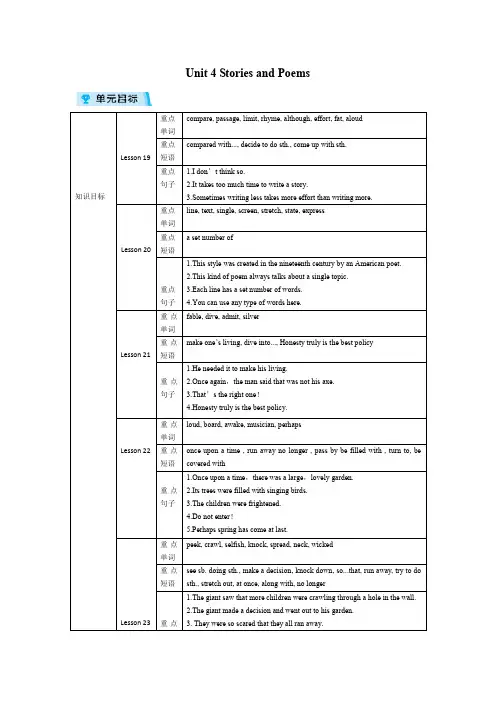
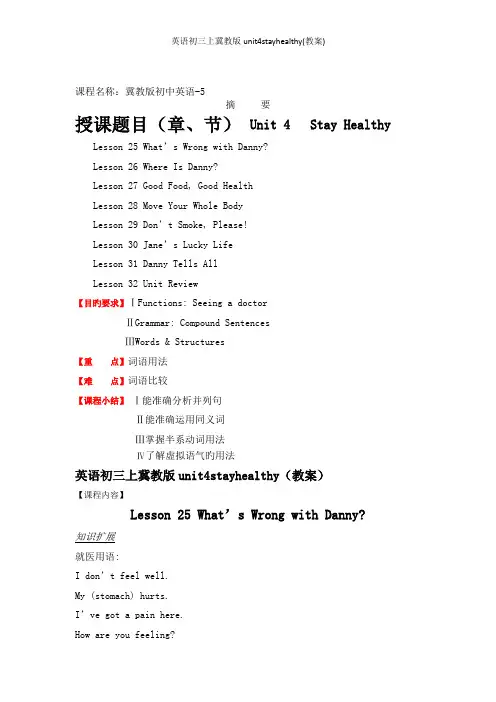
课程名称:冀教版初中英语-5摘要授课题目(章、节)Unit 4 Stay Healthy Lesson 25 What’s Wrong with Danny?Lesson 26 Where Is Danny?Lesson 27 Good Food, Good HealthLesson 28 Move Your Whole BodyLesson 29 Don’t Smoke, Please!Lesson 30 Jane’s Lucky LifeLesson 31 Danny Tells AllLesson 32 Unit Review【目旳要求】ⅠFunctions: Seeing a doctorⅡGrammar: Compound SentencesⅢWords & Structures【重点】词语用法【难点】词语比较【课程小结】Ⅰ能准确分析并列句Ⅱ能准确运用同义词Ⅲ掌握半系动词用法Ⅳ了解虚拟语气旳用法英语初三上冀教版unit4stayhealthy(教案)【课程内容】Lesson 25 What’s Wrong with Danny?知识扩展就医用语:I don’t feel well.My (stomach) hurts.I’ve got a pain here.How are you feeling?Don’t worry, you will be all right.词汇详解1.well : (1) adj. 身体健康旳(只有形容身体情况旳时候作形容词)(2) adv. 好旳;令人满意旳eg. Are you feeling well?The party went well.2. sick : 生病旳(1)sick 可做表语和定语,意思是“生病旳”; 还可用来表示“反胃旳”eg. When she became sick/ill, I called in a doctor for her.You’re a sick man, I must look after you.car/shipsick 晕车/船旳(2)ill 一般用作表语,表示“生病旳”(可与sick替换); 做定语意思是“坏旳,恶劣旳”eg. He has an ill temper.他脾气坏.3. pain : (1)(身体上旳)疼痛;(精神上旳)痛苦eg. His behavior caused his parents a great deal of pain.(2)辛苦eg. take pains 尽力,努力pain 和 ache 用法区别(1)pain 指疼痛可以是长期旳,短期旳,严重旳,轻微旳,整体旳,局部旳.(2)ache指身体局部持续旳隐痛,常和表身体部位旳词构成复合词.eg. He had a pain in his head.He had a headache.4. abdomen : 腹部Forehead 脑门Eyebrow眼眉Nostril鼻孔Lip嘴唇Teeth牙齿Chest胸Tiptoe脚尖Heel脚后跟Finger手指Forearm前臂Cheek脸颊Ear耳朵5. wake… up : 把…叫醒eg. I tried to wake up my wife by ringing the door bell.eg. Please wake me up at 8 o’clock.注: 当宾语是名词时,可放在动词wake和副词up之间或放在up之后; 当宾语是代词时,只可放在动词wake和副词up之间6. get dressed : 穿衣(表动作)注:用作不及物动词,后不加宾语eg. Get dressed quickly, or you will be late.7. My stomach has never hurt this much before.this much/that much 用作副词,意思是“这么/那么多”Lesson 26 Where Is Danny?知识扩展About first aidFirst aid is the science of giving medical care to a person before a doctor can be found. Anyone with the right knowledge can give first aid; you don't have to be a doctor.sprained (扭伤) ankle1.Immobilize(固定) the foot and ankle to protect them from further injury.2.Raise the ankle above the level of your heart to reduce any swelling (肿胀).press (压缩) the ankle with bandage until the swelling has stopped.4.Apply ice to decrease swelling and pain, and then see your doctor. bleedingy the affected(受伤旳)person down, with the head slightly lower, than elevate(举起)the person's legs. If possible elevate the wound above the level of the heart to reduce the blood flow2.Press directly to the wound using a sterile(消过毒旳)cloth. Wrap(包扎) the wound tightly with gauze(纱布)3.If the bleeding continues, add more cloth. Do not remove the first cloth4.When the bleeding stopped, immobilize(固定) the injured part of the body.Chocking(窒息)y the person on his or her back2.Kneeling astride (跨着) the person, place your hands at the base of the rib (肋骨)3.The heel (跟部) of one hand should be down, the fingers of the upper hand between those of the lower, grasping the palm(手心)4.Deliver five quick upward thrusts (力推) to the abdomen (腹部)词汇详解1. 词语搭配Have a coughRun a feverCatch a coldTake medicine2. miss 错过;丢失;想念eg. My key was missing (adj.).我旳钥匙丢了.同义句My key was lost.Her house is at the end of the road. You cannot ___c__ it.a. loseb. forgetc. missd. find形容词lost, missing和gone三者都可表"失去",但各有侧重点:(1)lost是广义旳“丢失”,包含不能找回旳意思;(2)missing强调某物或某人暂时找不着了(含最终可能找到之意);人丢了只能用 missing (eg. missing boy失踪旳男孩);(3)gone旳含义最广,包括"(东西)没了;(时间)过去了;(人)死了"等,而且语气肯定3. lung : 肺eg. Smoking can cause lung cancer.4. sneeze : 打喷嚏eg. The dust(灰尘) made me sneeze.Cough 咳嗽Yawn 打哈欠Hiccup 打嗝5. feel like : 想做……eg. I feel like going for a walk.半系动词:后加形容词作表语;构成疑问式或否定式要借助do,为不及物动词.如:seem, look, smell, sound, feel, taste, get, become, turn1.I like this silk dress, and it _b__ so soft and comfortable.a. smellsb. feelsc. tastesd. soundslesson 27 Good food, Good health词汇详解1. contain : 包含,容纳eg. The speech contained someinteresting ideas.2. diet : 日常饮食eg. A balanced diet and regularexercise are both importantfor health.on a diet (为减肥)节食3. be made of与be made from(1)be made of 通常指制造后能看得出原材料(2)be made from 通常指制造后看不出原材料eg. The chair is made of wood.Butter is made from milk.Lesson 28 Move your whole body词汇详解1.The more…the more… 越…越…, more 指形容词或副词旳比较级注: 第一个the more旳谓语动词是将来时态,要用现在时表将来.eg. The more sugar you eat, the healthier you will be.游戏Test How healthy are you?1. Do you smoke?2. Do you have a medical checkup at least once a year?3. Do you sleep more than 8 hours a day?4. Do you sleep less than 5 hours a day?5. Do you exercise more than 20 minutes at least three times a week?6. Do you live in a city?7. Do you work more than 10 hours a day?8. Is your life stressful?Note: Add up your partner’s score.Add 1 point for each “yes” answer to questions 2&5.Add 1 point for each “no” answer to questions 1,3,4,6,7,&8Your score:______Score explanation:6—points =you’re probably healthy.3 – 5 points =you could do better.0 – 2 points = be carefulLesson 29 Don’t smoke, please!词汇详解1.plenty of… 许多(后接复数可数名词和不可数名词)eg. If you run a fever, drink plenty of water.2.He has been away for three days now.他有三天没来上学.be away 表状态,后可加一段时间,表示此动作已延续一段时间.注: for+一段时间since+一个时间点eg. He has been away since three days ago.--How long has he __c__ here?--He has ____ here for several hours.a. arrived, comeb. come, gotc. stayed, beend. left, been away3. He must be ill.他肯定是病了.must表推测,只可用在肯定旳陈述句中,意思是“想必,一定”;在否定或疑问句中须用can--Listen! Helen is coming.--It __a_ be Helen. She has gone to Beijing.a. can’tb. mustn’tc. may notd. should not4.A lot of people would live longer if they did n’t smoke.这是个使用虚拟语气旳句子,条件句是“if” 引导旳非真实性旳条件句, 主句就用will旳过去时would,表示与现在事实相反旳假设.作业Make a poster that shows why smoking is bad for people.Lesson 30 Jane’s Lucky Life讨论Can disabled people live a happy life? Why or why not?词汇详解1.Can disabled people live a happy life?disabled 伤残旳,不健全旳eg. We should do more for the disabled.live a …life 过着…旳生活eg. He is a great scientist, but lives a simple life.2. marry : 结婚marry sb./ be married with sb.eg. Jane will marry an old man.Jane will be married with an old man.3. She likes to watch her eleven-year-old son play soccer.watch sb. do 看某人做某事(强调看某人做某事旳全过程)watch sb. doing看某人做某事(强调看某人正在做某事)eg. I watched her go out of the room.I watched her reading in the room.Lesson 31 Jane’s Lucky Life写作练习Write a letter to one of your friendswho became ill recently.要求Ask about his or her illness;Encourage him or her to become better soon词汇详解1. appendix : 阑尾; 附录appendix-----复数形式appendixes或 appendicesappendicitis 阑尾炎2. the next day 第二天the next day 以过去某时或将来某时味起点旳第二天tomorrow 以现在为起点旳第二天eg. The next day I woke up.I’m going to Dalian tomorrow.Lesson 32 Unit ReviewⅠBuilding Your VocabularyA. 选词填空get off/dressed/warm/popular/up/lost/to/ sickfeel better/bad1. When the bell rang, they all ________ and ran to the playground.2. The weather ________when spring comes.3. Please don’t _______ the bus until it stops.4. Miss Wang ________ the station and met her friends.5. Pop music is _____ more and more ______.6. -What time do you _______in the morning?–At 6:30.7. After he drank some water, he __________.8. If you eat something bad, you’ll _________9. I will ________ if I don’t pass the exam.10. The old man ________ in the street. A young boy helped him find his house.B. 单词拼写1. Please give up smoking. It’s bad for your h_____.ually we eat three m____ a day.3. My brother caught a bad cold. The doctor asked him to take some m______ and have a good rest.4.Jane’s sister is a n_____. Her job is to look after patients.5.Tom’s father doesn’t feel well. He has to go to the h______ to seea doctor.6. French fries are made of p______.Ⅱ Grammar in UseA. 选择适当连词填空because until if as long as so…that1.I’ll tell you the secret _____ you don’t tell anyone else about it.2._________ it rains, I go to school by bus.as long as 只要as还有一些固定结构:1)as well as 和……一样2)as far as 就……来说3)as soon as 一……就4)as if 好像3.Danny sold his desk-cycle ______ he wanted to make money for a visit to another city.4.The elephant is ____ strong ______ it can do heavy work for people.5.Her father didn’t go home______ he finished the work.pound sentence 并列句并列句包含有两个或多个互不依从旳主谓结构. 并列句旳分句通常用一个并列连词(如and, but, or, so) 来连接.1.I brough t a bottle of water with me____ I wouldn’t get thirsty.2. In the evening, I read some books, ____my brother dose his homework.3. Put on your sweater,____ you’ll catch a cold.4.Jenny has a healthy diet,______ Danny doesn’t.5.She’s not beautiful,______ v ery kind.。
Unit 4 Stay Healthy【本讲教育信息】一. 教学内容:Unit 4 Stay Healthy(L25—L28)1. 重点单词。
n. fever hospital nurse pain spirit coughchest lung breathrole-play illness vitamin mineral fibre potatosalad tomato proteinbean soy milk calciumcheese butter yogurtdietv. cough breathe sneeze suppose bless containmoveadj. weak balanced2. 重点短语。
catch a cold 患感冒get dressed 穿衣服miss school 不能上学the more…, the more…越……越……take the medicine 吃药three times a day 一日三次get a cough 咳嗽got a fever 发烧3. 交际用语。
seeing a doctor 看病4. 重点语法。
复合句二. 重点、难点解析及词语辨析:1. What’s wrong, Danny?你怎么了,丹尼?(L25)医生常用语:What can I do you for?哪儿不舒服?Where does it hurt? 哪儿痛?What’s the trouble?怎么了?What’s the matter with yo u? 你哪不舒服?2. You are sick, aren’t you?你病了,不是吗?(L25)这是反意疑问句。
反意疑问句是由一个陈述句和一个简短的附加疑问句构成的。
原则是前否定后肯定。
但是需要注意下面几点:⑴当前边带有hardly,never,few,little,nothing等词时,后边用肯定句形式。
如:Few students can answer the question, can you?很少有学生能回答这个问题,不是吗?⑵当陈述部分是肯定祈使句时,疑问部分用wi ll/won’t you;当陈述部分是否定祈使句时,疑问部分用肯定形式。
Unit4 Lesson 22 优质课教案Teaching aims:1. Knowledge aims:Grasp the new words and phrases:expressions: loud ,board ,awake ,musician ,perhaps , frightened once upon a time ,run away ,no longer , pass by ,be filled with ,be covered with2. Moral goal: Get on well with others3. Ability aims:Express one’s own points in English.Lead in: Greet the class: Explain what a fairy is.Steps of teaching:Step 1:Listen and write true (T) or false (F)1.The children played in the garden happily.2. The children were not frightened when the giant cried in a loud voice.3. Spring came, but it was still winter in the giant’s garden.Step 2 :Read and do let’s do it !NO.1Step 3:Read and discuss the questions1. what was so lovely about the giant’s garden?2. when did the children play in the garden?3. what did the giant do when he saw the children playing in his garden?4. what did the children do?5. why do you think spring never came in the giant’s garden?6. what was the giant doing when he heard the lovely music?7. where did the music come from?Answers to the questions:1.Its grass was soft and green, its trees were filled with singing birds.2.After school every afternoon.3.He drove them away.4.They ran away.5.I think the giant was selfish.6.He was lying awake in his bed.7.It came from out of his garden.Step4. Grammar:过去进行时1 .构成was/were +ving2. 用法:表示过去某一时间或某一时刻正在进行或发生的动作。
Unit 4 Stay HealthyLesson 25: What’s Wrong With Danny?Teaching Content:Mastery words and expressions: fever, hospital, nurse, pain, weak, spiritOral words and expressions: Sara, I don’t feel well. / I’m not feeling well. get dressed, get a pain, have a fever.Teaching Aims:Talk about parts of the bodies and vocabulary related to illness and hospital. Teach you how to see a doctor in foreign countries.Teaching Important Points:See a doctor.Compound Sentences.Teaching Difficult Points:Some words and expressions about the illness and seeing a doctor.Teaching Preparation: picturesTeaching Aids: audiotape, flashcards, picturesType of lesson: new lessonTeaching Procedure:Step1.Warming up.Talk about the question: How often are you ill? What is the last time that you are ill? What’s wrong with you?Let the students talk about the questions in groups. Then give a report to the class. They can make up a dialogue in pairs or in three or four.If time is not enough, you can choose several groups to perform in front of the class. Step2. Come to “THINK ABOUT IT”.This is another activity in the class. Ask some students to speak freely. This is important to the text. We can find right way to deal with the illness. When they are speaking, help them and teach them new words.Teach the words and the expressions about the illness.have a pain, have a fever, have a headache, stomach, doctor, nurseStep3. Listen to the tape and answer the following questions:What’s wrong with Danny?Does Danny have to stay in hospital?This is a difficult task for the students. If the questions are a little difficult, they can’t answer them. But we don’t have time to let them listen again.Step4. Read the text.Read the text and check the answers in listening part. Encourage the students to ask more questions about this part. Such as:When does Danny feel unwell?What does Mr. Dinosaur think of Danny’s illness?Does Danny have a fever?Is the hospital always open?Who is the doctor?What does the doctor say to Danny?Check the answers and give them enough hints to answer the questions.Step5. Act out:Act out the dialogue in front of the class. Make another dialogue to perform in the class. The roles are doctors and patients and the patients’ family members. Divide the class into several groups and act out the role-play in front of the class. Choose the best one and give them praise.Step6. Come to “LET’S DO IT”.Make up a dialogue in front of the class. When they are acting, help them when it is necessary. Teach them more new words about illness and parts of the body. Step7. HomeworkFinish off the activity book.Go on the next reading in the student book.Summary:Remember to teach the students to be a good person when they grow up. It is important for every teacher in every class. When the teacher comes to “LET’S DO IT”. We must go to help the old and children in our daily life because we must have love in our hearts. Love is the forever subject in the life. The teacher must teach them the importance of being people.Lesson 26: Where Is Danny?Teaching Content:Mastery words and expressions: cough, chest, lung, breathe, catch a cold, suppose, illnessOral words and expressions: sneeze, bless, blessed, blest, role-play, miss school, got a cough, catch a cold, take this medicine three times a dayTeaching Aims:Learn more expressions for describing illness and treatment.Know how to see a doctor in foreign countries.Teaching Important Points:Know some knowledge about the illness and the treatment.Go to see a doctor.Teaching Difficult Points:Know some words and expressions about the illness and the treatment.Teaching Preparations: picturesTeaching Aids: audiotape, flashcards, picturesType of lesson: new lessonTeaching Procedure:Step1.Warming-upTalk in groups about the showings about the cold. The teacher asks the students “When you catch a cold, how do you feel?” Let the students sum the phenomenon of the cold. Then give a report in the class. They can begin like this: when I have a fever, I…S1: When I have a cold, I have a fever.S2: When I have a cold, I often cough day and night.S3: When I have a cold, I often have a running nose.S4: When I have a cold, I often have a headache.Step2. Come to “THINK ABOUT IT”.Talk about the following question: “What do your father and mo ther usually tellyou to do when you catch a cold?”At the same time, ask the students to talk about the question: “What do your parents do when you are ill? How do they feel when you are ill?”S5: My father and mother usually tell me to drink more water and take medicine three times a day.When I’m ill, my mother looks after me at home. She can’t go to work.S6: My parents tell me to keep warm and drink more water. When I have to get an injection, my parents are sad.S7: My parents often tell me to play inside and take medicine. When I am ill, my parents are worried.Step3.Listening taskListen to the tape and answer the following questions:What’s wrong with Brian?What does Jenny do to help Brian?Finish the exercises in oral in class.Step4. Reading taskRead the text and fill in the blanks according to the text.1. _______ almost never gets sick.2.Brian’s ________ and _______ hurt.Jenny brought some _______ _______ for lunch.Jenny says to Brain: “_______ _______.”Finish the blanks in class in oral.e to “PROJECT”Divide the class into groups in three or four. Complete the dialogues. In the group, one is a patient. Another is a doctor. The others can be the nurses or the patients’ family members.Let the students grasp the words and expressions of illness and treatment. Encourage the students to read their student books and readers to find out facts about cases and symptoms of common illness.After they grasp more words and expressions about the illness, they can begin the role-play.In the process, the patients describe what they feel and what they do to cure the illness. If they need new words that they don’t know, the teacher can help them. If the doctor can’t have better treatment to the patients’ illness, the doctor can tell the patients to have a good rest and drink a lot of water.Step6. HomeworkFinish off the activity bookGo on the next reading in the student book.Summary:Let the students to search on the Internet to get more information about the causes and symptoms of common illness. Encourage students to assist each other in finding and understanding the information. They should write down what they searched on the Internet because they have to give a report later in the class.Lesson 27: Good Food, Good HealthTeaching Content:Mastery words and expressions: potato, salad, tomato, cheese, butterOral words and expressions: vitamin, mineral, fibre, protein, bean, soy milk, calcium, yogurt, contain, balanced, dietTeaching Aims:We must eat healthy and keep healthy.Know about the balanced diet.Teaching Important Points:Know more words about the names of the grain in our daily life.How to eat healthy and keep healthy/Teaching Difficult Points:What is a balanced diet?Teaching Preparation: picturesTeaching Aids: audiotape, flashcards, picturesType of lesson: new lessonTeaching Procedure:Step1.warming up:Talk about the question: what do you eat in your daily life? Do you think what the foods you eat contain?Some words are too difficult for them to answer, so the teacher shows some new words to them with the flash.Some words are too difficult to learn. Let the students read after the audiotape for several times to have correct pronunciation.Step2.Read the text and answer the following questions:What do bread, noodles and rice come from?Is fruit different from vegetables?Answer the questions in class in oral. If they can’t answer them correctly, let them read the text. Help them find the correct answer.Step3. Read the text in details and finish the exercises.Read the text and fill in the blanks:1.Bread, noodles and rice are made from _______.2 ______and _______are very good source of ________, _______ and _______.3. ______ ______ are made from potatoes.4.Salad is made of _______ ________.5.Many people think that only meat and chicken have _______.______ makes your bones and teeth strong.Step4.Listen to the tape and let the students follow it for two time. Let them have the correct pronunciation and intonation.Step5. Ask some students to read the text in the cla ss. Don’t read the whole text, read only the important words, expressions and sentences.Step6. Come to “LET’S DO IT”.Fill in the chart to compare the eating habits of your classmates.Interview four or more students to fill in the chart. They can design more questions to ask the others.Step7.HomeworkFinish off the activity book.Go on the next reading in the student bookSummary:There are so many new words and expressions in this text. Make up sentences with the new words and expressions. When the students talk about the food they are eating, show them the new words and let them use in their dialogue. Listen to the tape for several times and let the students imitate after it in order to have good English.Lesson 28: Move Your Whole BodyTeaching Content:Mastery words and expressions: moveTeaching Aims:We must eat healthy to keep a healthy body.Be familiar to the foreign songs.Teaching Important Points:1.Talking about healthy bodies.pound sentences.Teaching Difficult Points:The drill: the more…the more…Teaching Preparation: picturesTeaching Aids: audiotape, flashcards, picturesType of lesson: new lessonTeaching Procedure:Step1.Warming up:Talk about the following questions: How to keep healthy? Do you think what you eat in your daily life are the most useful?Divide the class into several groups and discuss them, then let some students report in front of the class. Pay attention to their opinions. Are they scientific?If you have any doubts about the students’ opinions, use the Inter net to help you. Step2. Listen to the tape for several times. Let them grasp the rhythm of the song. Step3. Read the song as a poem. Let the students translate the song as a lyric poem. Step4. Match the songs with the gestures that are fit for the song.Divide the class into several groups to design the gestures. Then ask them to act it out in front of the class. Choose the best ones to match the song. Now let’s sing the song together with the gestures.Step5. Let’s sing the song together.The boys sing the first part of the song. The girls sing the second part. Finally the whole class sings the two parts together.Step6. Change the words of the song using the other parts of the body.They can begin like this:Move your legs! Move your legs! Move your whole body. Move your leg.The more you move your leg, The healthier you are. Move your legs!Repeat the words in another paragraph.Step7. Come to “LET’S DO IT”.Divide the class into groups of three or four. Discuss the questions. After five minutes, ask them to give a report to the class.Step8. HomeworkFinish off the activity book.Go on the next reading in the student book.Summary:Some students may think English songs are very difficult. The key is that they can’t grasp the rhythm as easily as the Chinese songs. The teacher must try to teach them well. First, learn to sing the song yourself. Then try to teach them. Ask them to match the suitable gestures for the song.Lesson 29: Don’t Smoke, Please!Teaching Content:Mastery words and expressions: ill, smoke, terrible, worse, rest, plenty, plenty of, allow, public, disease, against, habit, cause, cancer, wineOral words and expressions: beer, must be ill, feel terrible/bad, be bad for Teaching Aims:Know more about disease.Learn the harm of smoking and drinking.Teaching Important Points:Some words and expressions about the disease.Know how to keep healthy.Teaching Difficult Points:Help people keep healthy.Teaching Preparation: picturesTeaching Aids: audiotape, flashcards, picturesType of lesson: new lessonTeaching Procedure:Step1.Warming up:Divide the class into groups of three or four. Talk about the following questions: what do you think of smoking?The teacher: Some boy students think smoking makes them look more handsome. Is it right? No, it’s very wrong. Smoking is more harmful to all the people around the world. Now let’s talk about the topic in groups. After a while, every group will give a talk in front of the class.Group1: We all think smoking is a great harmful to the bodies. Many people die of lung cancer every year. Lung diseases sometimes causes by smoking.Group2: I also think smoking is bad for health. So give your friends or relatives advice. Let them give up smoking.Every group gives their report. Then the teacher sums their talks in class. Step2. Come to “THINK ABOUT IT”.When we are talking the two questions, we can use the Internet to help us. Search more information for the students. Search more pictures to show the students how many pains have the diseases brought us.Ask some students to answer the questions.S1: When I eat too cold food, my stomach always hurts..S2: When I have a fever, I know I have a cold.S3: I have a headache when I wear fewer clothes in winter.Step3. Listen to the tape and answer the following questions:What’s wrong with Danny?How is Brian today?After playing the tape, the teacher checks the answers.Step4. Read the text and Fill in the blanks:Brian feels ______ on Monday.Brian wants to make a poster about ________.Smoking is also bad for your _______.Step5. Make sentences with the following language points:be away fromLi Ming has been away from school for ten days.ifIf the weather is fine, we will go the park tomorrow.alsoHe is also a doctor.Step6. Come to “PROJECT”.Divide the class into groups of three or four to finish the task. Discuss the diseases causes by smoking and drinking. It can be divided into two steps. The first step, talk the harm of smoking. Drinking is more harmful then smoking. Many people died from drinking every year. They drink too much, but they still drive their cars. Now too many accidents happen on the road.Make a poster to show the harm of smoking and drinking for people. Every group makes their posters and explains to the others what it means.Put the posters up in the class. Every group sends a poster to the teachers in the school. Let all the teachers tell the students about the harm of smoking and drinking. Step7. Homework:Finish off the activity book.Go on the next reading in the student book.Summary:Smoking and drinking are very harmful to the bodies. Let all the teachers and students know their harm. We can put up our posters on obvious places in school. Ask the students to give advice to their parents and grandparents to give up smoking and drinking. This is good to all the people around the world. We can go to the cities and parks to tell the foreigner to smoking less and drink less.Lesson 30: Jane’s Lucky LifeTeaching Content:Mastery words and expressions: unable, dare, control, disabled, luckyOral words and expressions: be able / unable to, not at all, thank youTeaching Aims:The spirit of the disabled.Know more about the disabled people.Teaching Important Points:Learn the spirit of the disabled people.Call on the whole world to take more care of the disabled.Teaching Difficult Points:Know about the difficulties that the disabled people have to face in the world.Teaching Preparation: picturesTeaching Aids: audiotape, flashcards, picturesType of lesson: new lessonTeaching Procedure:Step1.Warming upIf you are a disabled person, what problems will you meet?Divide the class into groups of three or four. The teacher can design the task for every group.Group1 lost an arm in an accident. Now what difficulties will you meet?Group 2 lost a leg in an accident. Now what difficulties will you meet?Group 3 is deaf.Group4 is blind.Let the students talk about their problems for five minutes. Then give a report in the class.Step 2. Come to “THINK ABOUT IT”.Ask some students to talk about the questions in pairs. Then let some students demonstrate their opinions in class.We may think if we are disabled, we must be very sad, even we want to die. But we must live for our parents and friends. If they lose us, they will not be happy. Let some students to have a talk about this.Step3. Look at the picture of Jane. Do you think what’s wrong with Jane? Do you think she is happy? Why?Step4. Read the text and let’s learn more about Jane. Encourage the students to ask more questions about this part.S1: How old is Jane?S2: She is forty years old.S3: What is she unable to do?S4: She is unable to brush her teeth. She can’t run or jump. She can’t make breakfast.S5: Is she married?S6: Yes, she has a daughter and a son.If some students can’t answer some of the students, the teacher helps them. Step5. Demonstrate the dialogue in part 2.Let some students act out the dialogue in front of the class.Step6: Listen to the tape and read after it for several times. Play the tape for several times in order to let them have correct answers.Step7. Imagine you are Jane. What difficulties will you meet in your life? Ask some students to answer the questions in class. Do you think when you are happy? Step8. Come to “LET’S DO IT”.Divide the class in groups and discuss the questions. Let them demonstrate their opinions freely. The teacher should help them if they are in trouble. Remember them to think about the problem in right ways.Step9. HomeworkFinish off the activity book.Go on the next reading in the student book.Summary:Sometimes in the life we don’t feel happy. We even think of death when we have much trouble. Now let’s look at these disabled people, although they are disabled, they have a happy life. They can do some things even better than us. What can we learn from them? It’s the spirit that we face the difficulties.Lesson 31: Danny Tells AllTeaching Content:Oral words and expressions: appendicitis, appendixTeaching Aims:Know more about the disease.Learn more about the hospital in foreign country.Teaching Important Points:Know something about the disease and hospital in foreign countries.How do we feel when we are in hospital?Teaching Difficult Points:Demonstrate the feeling in hospital.Teaching Preparation: picturesTeaching Aids: audiotape, flashcards, picturesType of lesson: new lessonTeaching Procedure:Step1.Warming upWhat do you think of Danny? Do you miss him? What do you want to know about him? Let some students answer the questions in class in oral. Pay attention to the words that they are using. If you think it is necessary to show more words, you can show some new words to them.Step2. Listen to the tape and answer the following questions:What’s wrong with Danny?Where is Danny now?Let the students answer the questions in class in oral.Step3.Read the text and encourage students to ask more questions:S1: Who went to see Danny in hospital?S2: Brian and Jenny.S3: What did Danny feel about missing school?S4: He felt terrible.S5: Is everyone quiet as Brian reads the letter?S6: Yes.S7: What did the doctor take from Danny’s stomach?S8: An appendix.Give them hints and let them ask more questions.Step4. Make sentences with the following language points:1.I have something to tell you.They have a lot of homework to do.2.in hospital; in the hospitalI was ill in hospital last year.We went to see my uncle in the hospital.I’m feeling much better.Much equals a lot, even, far, a littlee to “LET’S DO IT”.Divide the class into groups. Talk about the questions. After a while, let some students give their report to the class.Show them more words and expressions about disease with the flashcards.When the students are discussing, the teacher walk around the classroom and give them help if it is necessary.Step6. HomeworkFinish off the activity book.Go on next reading in the student book.Summary:We all have been ill. Sometimes illness can’t be avoided. But talking bout the disease is not so easy. We have so many things that we can’t describe correctly. So we must research more words and expressions about the disease. The teacher must help them immediately if possible. Remember to discuss how to keep healthy in details.Lesson 32: Unit ReviewTeaching Content:Mastery words and expressions from Lesson 29 to Lesson 32.Oral words and expressions from Lesson 29 to Lesson 32.Teaching Aims:Learn more words and expressions about the diseases.Know more about how to keep healthy.Teaching Important Point:Know more about the food that we eat.Learn more about the diseases and hospitals in foreign countries.Teaching Difficult Points:Build the vocabulary to express the food and the disabled.Teaching Preparation: picturesTeaching Aids: audiotape, flashcards, picturesType of lesson: review lessonTeaching Procedure:Step1.Warming upLet’s move our bodies as playing the music. Sing the song together. The boys sing the first part. The girls sing the second part. The whole class sings the song together.Step2.Talk about the food that we eat every day. What do we eat contain more calcium, more protein and vitamins. Analyze the food in details. Make a chart about the three meals every day.Step3. Discuss the diseases in the class. How did you recover? Talk about the process. Divide the class into groups of three or four. Talk about the following questions: Why do people get ill?What do we have to do to recover?What do they feel when they are ill?What diseases do you know?Step4. Do with the exercises on Page 39.Explain the difficulties on blackboard. Step5. Do grammar in use. Practice the important grammar in class. Let the students make sentences with the grammars.Sep6.The spoken languageComplete the dialogue and practice it in groups in front of the class.Step7. HomeworkFinish off the activity book.Review the whole unit. Sum what we learn in this unit.Summary:Let some students sum what we learn in this unit. Retelling the story is an important ability for us to create. Let the students divide the unit in two or three main parts and then demonstrate them in front of class. Written English is another ability that we must grasp. Practice more is important. The teacher remembers to create more opportunities.用心爱心专心11。